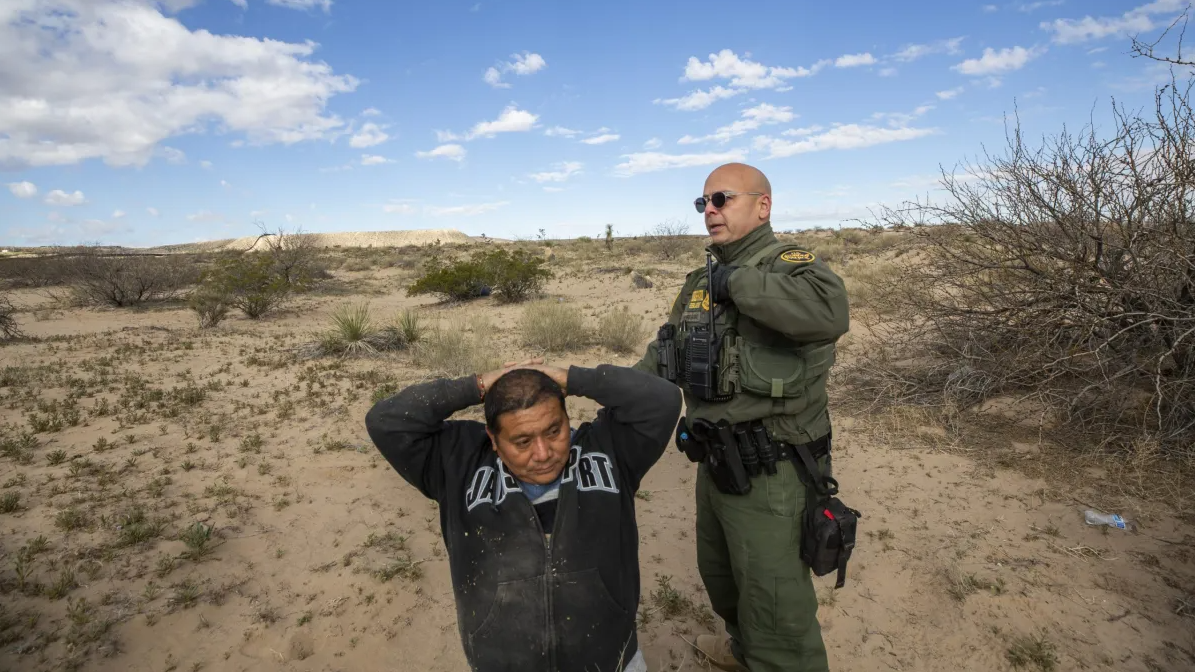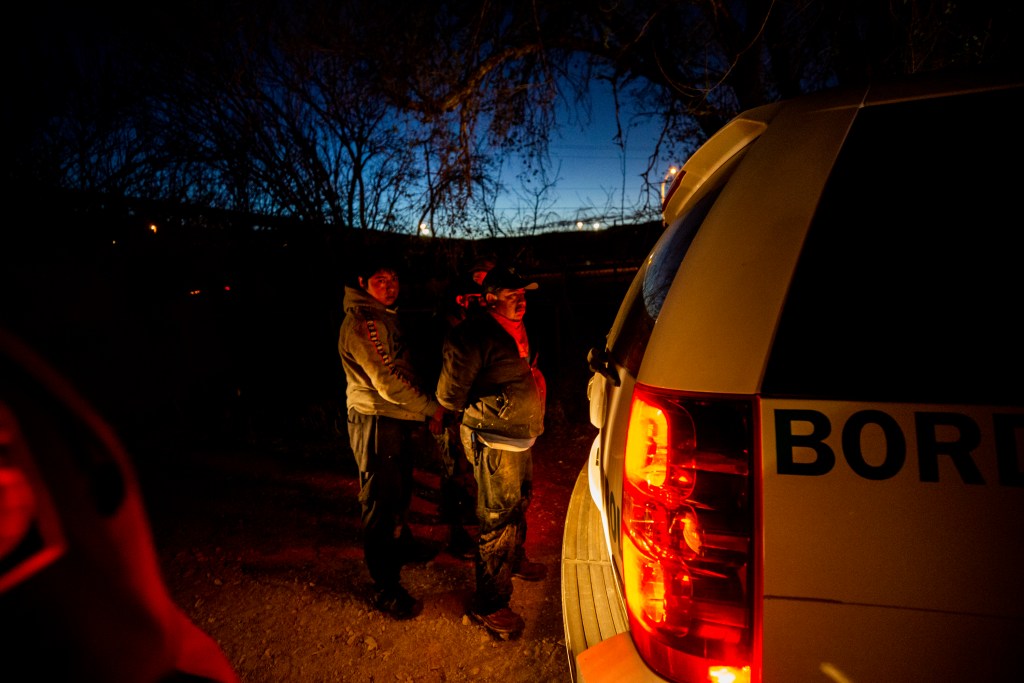Border Patrol plans return to jail time for illegal border crossing

By Puente News Collaborative via Lauren Villagran/El Paso Times
SUNLAND PARK, N.M. — Border Patrol agent Orlando Marrero-Rubio spotted two men hiding in the low creosote brush less than a mile north of the U.S.-Mexico border fence.
He pulled the men from Guatemala and Ecuador from the desert sand and gave orders in Spanish: Let's go. Give me your cell phone. Hands behind your head. Get up. Hands behind your head!
The men, both in their 40s, had crossed illegally. In the waning days of Title 42, they would be among the last to be expelled by Border Patrol with no legal consequence: no deportation record, no criminal charge.
The men would be summarily returned, to Mexico or their country of origin, as migrants had been nearly 2.8 million times during three years of the pandemic-era expulsion policy — coming to an end May 11. For those who attempted to cross illegally, the Title 42 public health order created a revolving door at the border that will soon be slammed shut.
When Title 42 expires on May 11, the Biden administration has promised to return to enforcing Title 8, the nation's immigration law. Legal provisions for asylum will be back in force, as will civil penalties for immigration violations and criminal prosecution for unlawful border crossings.
Homeland Security Secretary Alejandro Mayorkas said in April that Title 8 "carries stiff consequences for irregular migration, including at least a five-year ban on reentry and potential criminal prosecution for repeated attempts to cross unlawfully."
"The return to processing migrants under Title 8 authorities will be swift and immediate," he said.
How criminal prosecution of immigration offenses will factor into the Biden administration's border strategy — and whether jail time will serve as a deterrent during a new era of migration — remain open questions.
"I imagine those criminal prosecutions will probably come back but I don't know how effective they will be at knocking down the numbers," said Laura Collins, an immigration expert at the Dallas-based George W. Bush Institute. "I don't put much emphasis on deterrence because it is relatively ineffective when there is a robust economy or when you have a refugee crisis."
Border Patrol El Paso Sector Chief Scott Good told the El Paso Times the agency will be using Title 8 "as an enforcement measure, or a tool" when Title 42 expulsions go away. Border Patrol will target people for prosecution using these aggravating factors: migrants who, in trying to evade apprehension, put people at risk or damage property; and anyone who harbors or transports migrants.
"We've had a lot of migrants trying to evade and that comes with people who destroy property and who put people's lives at risk," Good said. "That's the major one: the smugglers, the load drivers, the stash houses."
Nia Rucker witnessed the history of immigration prosecutions as a former federal public defender in U.S. District Court in southern New Mexico. Now as policy counsel and regional manager for ACLU New Mexico, Rucker said she worries about a return to past enforcement strategies, "when we were criminalizing people for fleeing violence," she said.
"The punishment of being in jail is so disconnected from the reasons people are coming," she said. "It doesn't deter anybody and it exacerbates the situation for people who are very vulnerable."
After Title 42, a return to 'consequences delivery'
Before the pandemic, criminal prosecutions of "entry without inspection," a federal misdemeanor, and "unlawful re-entry," a felony, were a cornerstone of the U.S. government's border enforcement strategy, along with prosecutions of more serious felony charges for smuggling or harboring undocumented migrants.

The Department of Homeland Security called the approach "consequences delivery." The Justice Department made immigration offenses among most-prosecuted crimes in federal courts.
The number of immigration-related prosecutions topped 80,000 annually in seven of 10 years between 2008 and 2018, according to the Pew Research Center, more than double the level in the four years prior. They hit an all-time peak over 110,000 in 2019, when nearly two-thirds of criminal prosecutions nationwide were classified by federal prosecutors as immigration-related, according to TRAC, a data research organization at Syracuse University.
Previous Democrat and Republican administrations relied on prosecutions and jail time in their border strategy.
The first spike in prosecution of low-level immigration offenses came in 2005 during the George W. Bush administration when a joint Homeland Security and Justice Department initiative called "Operation Streamline" led to mass prosecutions in some border jurisdictions. Dozens of migrants were charged and sentenced in groups with little time to speak to an attorney.
Immigration prosecutions surged again during the Obama administration, swelling to record levels. But a zeal to prosecute all adult migrants at the border, in a policy labeled "zero tolerance," led the Trump administration to break the record — and drove the administration's widely reviled family separation policy.
The backlash to that policy, coupled with Title 42 expulsions during the pandemic, all but ended low-level immigration prosecutions.
Prosecutions in federal court for illegal entry and re-entry plunged from more than 10,000 per month in 2018 to fewer than 1,500 per month in 2020, according to TRAC data. They edged higher in 2022 but have remained below 2,000 per month through February 2023.
Busy federal courtrooms at the U.S.-Mexico border
Before the COVID-19 pandemic, the criminal dockets of the five federal judicial districts along the Southwest border were thick with immigration prosecutions, and U.S. District Judge Robert Brack's courtroom in Las Cruces, in southern New Mexico, was the busiest in the nation.
He had the highest criminal caseload of any federal judge in 2018.
Brack sentenced 6,585 defendants that year, 85% of them convicted for immigration offenses, according to TRAC, when an extraordinary criminal caseload for a judge in the U.S. interior barely topped 1,000 cases.
He often gave "time served," usually six to eight weeks of jail time to migrants who shuffled into his courtroom chained at the wrist and ankles. He heard scores of stories of men and women risking jail time to find a job or return to their spouses and families in the U.S. He handed down longer sentences to those caught carrying drugs or involved in human smuggling.
After serving a sentence for an immigration-related offense, migrants would often be deported with five- to 10-year bans on their return or eligibility for a lawful return to the U.S.
"I was in court every day, sentencing every day, for a six- or seven-year period ending in about 2018," said Brack. "I was seeing more people than anybody. That was how we conducted business along the border then. The system became very efficient and we would move large numbers."
The increase in prosecutions during that time coincided with a decline in Border Patrol apprehensions to historically low levels. The record of annual apprehensions, consistently over 1 million per year, dropped to a low of roughly 304,000 in 2017.
But immigration experts caution against drawing broad conclusions.
Research suggests that the threat of prosecution and jail time for illegal entry or re-entry can have a deterrent effect on the individual who is prosecuted but, as a public policy, prosecution does little to deter unlawful migration generally.
"The wealth of research is pretty inconclusive," said Austin Kocher, a researcher at TRAC. "More prosecutions don't necessarily mean less unlawful entry. At the individual level, prosecutions can have an effect, but the number of people who are coming are not bounded; new people are coming all the time."
Other factors drove Border Patrol apprehensions down when prosecutions were high.
Migration patterns were different; the majority of those crossing the U.S.-Mexico border without permission were adults, mostly men from Mexico and Central America, looking for work or trying to reunite with family. In 2008, the Great Recession dried up demand for labor. Thousands of migrants returned home, and put off plans to come north.
After 2018, the number of migrants fleeing violence and political persecution, and arriving in family units, rose dramatically. A person who claims a credible fear of returning to their homeland has historically been afforded an opportunity to seek asylum under U.S. law — and cannot be criminally charged.
Wondering 'whether it was a critical piece'
Enforcement of the criminal penalties outlined in Title 8 requires two initial steps: Border Patrol agents refer migrants for prosecution, and U.S. attorneys accept the cases for prosecution. It's not clear yet how U.S. attorneys in the five border districts will respond.
The Justice Department didn't respond to multiple requests for comment regarding guidance to U.S. attorneys on how to handle prosecutions of illegal entry and re-entry charges, or whether additional resources will be provided to their offices.
U.S. attorneys for the District of New Mexico Alexander M.M. Uballez and West Texas' Jaime Esparza, who handle criminal cases referred by Border Patrol's El Paso Sector, also declined interview requests through their spokespeople.
"I can't comment on the guidance, but the U.S. Attorney's Office for the Western District of Texas responds to the cases that our border agency partners bring us," said spokesman Michael Lahrman. "I also cannot speculate on what might happen in the event Title 42 expulsions end, however our office is working with our border agency partners to ensure proper preparation."
In the Las Cruces federal court, Brack, now a senior judge with a smaller caseload, said he is seeing unlawful re-entry cases again for the first time in years.
"I want to think looking back that it was an important part of the overall puzzle, and that it did have a deterrent effect," Brack said. "But knowing that people are still coming in large numbers, and those prosecutions don't happen anymore, I'm left to wonder whether it was a critical piece."
This story is part of the Puente News Collaborative.
